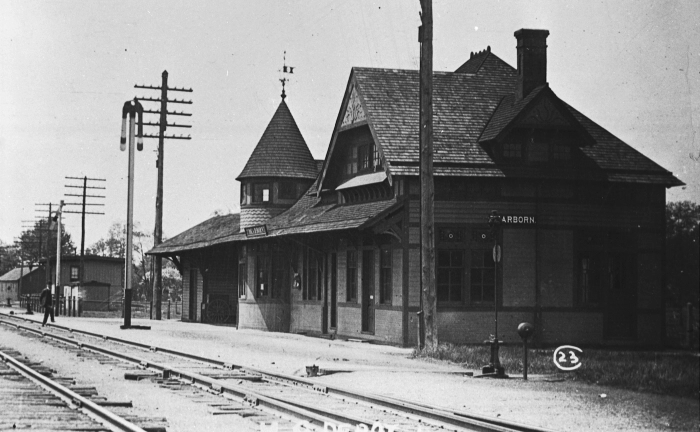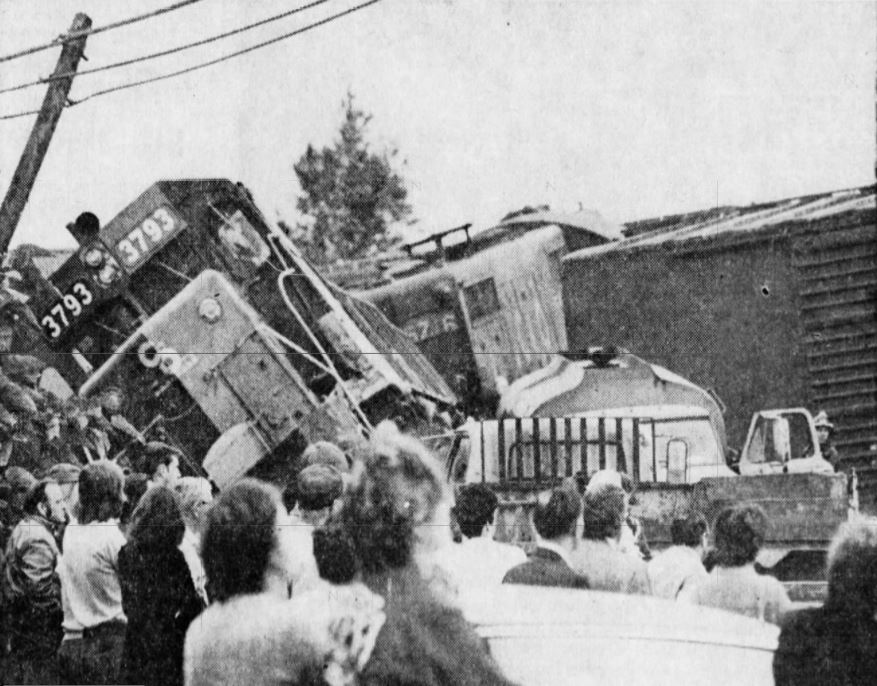- Details
- Hits: 3583
Station: Dearborn, MI

[EugeneBurrell-NathanNieteringColl].webp)
.JPG)
Dearbornville was a station stop on the original Central railroad line (later MC/NYC/PC/Conrail/NS) nine miles west of the MC's Detroit riverfront station.
Photo info: Top, the Dearborn village train station was located south of Michigan Avenue near Monroe Street in an area now known as "west" Dearborn. [Mark Dobronski collection] 2nd photo, the NYC's Twilight Limited is westbound at Dearborn in the 1960's. [Eugene Burrell photo, Nathan Nietering collection]. 3rd image, a map of the junction of the MC main line and their Detroit, Delray & Dearborn branch which ran from this location to the River Rouge area at YD Tower. Ford built a tractor plant at this location in the early 20th century. Greenfield Village was also constructed east of here in the late 1920's. The DD&D branch was removed after the Junction Yard branch was built. The DD&D right of way crossed through the middle of what is now the Ford Engineering Test Track, also an airport in earlier days. Drawing from blueprints at the State of Michigan Archive.[Dale Berry]
Notes
Dearborn, Michigan was located about 10 miles west of the original Michigan Central 3rd Street Station in Detroit. At the time of the building of the Central route by the State of Michigan in the early 1830's, Dearborn was a stage coach stop on the federal highway which connected Detroit with the Chicago area. The area boasted a small garrison for the U.S. Army and the area near what is now known as Michigan Avenue and Monroe Streets was home to a commandants quarters, armory, and other buildings.
The station pictured here was located south of Michigan Avenue, near Monroe Street which is actually now known as West Dearborn. In the 120 or so years that the depot or a predecessor existed, Dearborn was an important point on the Michigan Central. The area was double tracked here in the late 1800's and each direction had its own passing siding of over 100 cars, some of the longest on the Central. In the early 1900's, a junction switch was installed for a cutoff track which allowed eastbound trains to bypass the Detroit terminal area (the Detroit, Delray and Dearborn branch, see below). This branch was discontinued around 1920 when the Junction Yard branch was installed to serve the Ford Rouge plant.
The Dearborn station was finally torn down and not replaced in the 1950's.
Time Line
1838. The Brady Guards of Detroit are stationed at Dearbornville to guard the Arsenal, upon the requisition of Capt. Webb, of the U.S. Army. [Constantine Republican-1838-0117] The troops, under the command of Genral Brady, included three companies, one at Dearbornville, one at For Gratiot (in St. Clair county) and one in the city of Detroit. [DFP-1838-0129]
1838. The co-partnership existing and operating in the manufacturing lumber at the Dearbornville steam mill was dissolved by mutual consent. The business will be continued and will have at all times a large quantity of lumber for sale at the railroad depot. [DFP-1838-0613]
1891. The Ten Eyck farm in Dearborn was sold by C.B. Ten Eyke for $100,000 to Detroit partners. The deeds call for 400 acres. [LDP-1891-0219]
1906. Because D.U.R. conductor George Trollop did two men's work on the Ypsi-Ann line last Saturday there is a determined effort by the union to have him discharged. Trollop went to the powerhouse to take out his car. The motorman was not there, so Trollop started out alone, thinking he would save the company the expense of employing a motorman. He would allow the car to roll along slowly until he had collected the fares when he would resume his position in the front vestibule. Trollop's act did not please the D.U.R, and he was discharged. But his intention to save the company money was apparently reconsidered and he was reinstated. Now the union is up in arms because Trollop did the work of two men, instead of waiting for another motorman to be given a change to earn a day's wages. [DFP-1906-1201]
1908. Some of the changes on the MC under the (new) nine-hour law. The night offices at Dearborn, Grass Lake, Francisco, Wiard's will be closed at night and employees transferred and other offices. The Dearborn office will be closed and another operator will be assigned to the junction yards office. [PHTH-1908-0307]
1917. This station was staffed during the day by an agent/operator. [TRT]
1920. On the Michigan Central, this is a passenger, freight and express agency joint with the American Railway Express Company. W. J. Phipps is the agent. The telegraph call sign is "DN". [MCOAS]
1931. The MPUC approves the separation of grades between the MC Junction Yard branch and Airport Drive (now Rotunda Drive), just north of Schaefer tower. The road will go under the railroad. [MPUC-1931]
1931. November. A railroad crossing of the MC Junction Yard branch and Airport Drive (later Rotunda Drive) is being grade separated. The land that has been dedicated for the road by Henry Ford. The subway will provide a 60-foot clear opening for the highway and two sidewalks each eight feet wide. The project is estimated to cost $175,000. [DFP-1931-1122]

The impact of the crash sent freight cars and locomotives sprawling across the tracks at Barrie, just south of Tireman. One car plowed into the backyard of Dearborn councilman Herbert Amthor. The C&O official said the accident occurred when an eastbound train stopped at a signal and was rammed from behind by a yard engine pulling 25 cars. A third westbound train was also involved. [DFP-1973-0918]
Bibliography
The following sources are utilized in this website. [SOURCE-YEAR-MMDD-PG]:
- [AAB| = All Aboard!, by Willis Dunbar, Eerdmans Publishing, Grand Rapids ©1969.
- [AAN] = Alpena Argus newspaper.
- [AARQJ] = American Association of Railroads Quiz Jr. pamphlet. © 1956
- [AATHA] = Ann Arbor Railroad Technical and Historical Association newsletter "The Double A"
- [AB] = Information provided at Michigan History Conference from Andrew Bailey, Port Huron, MI

